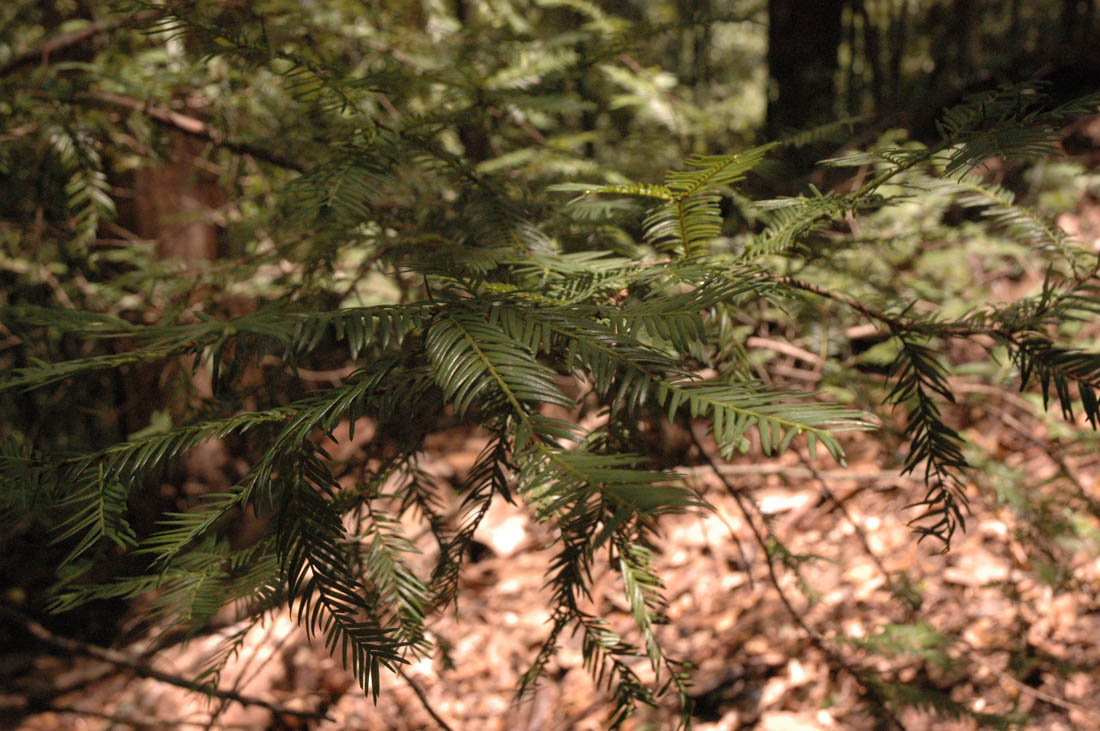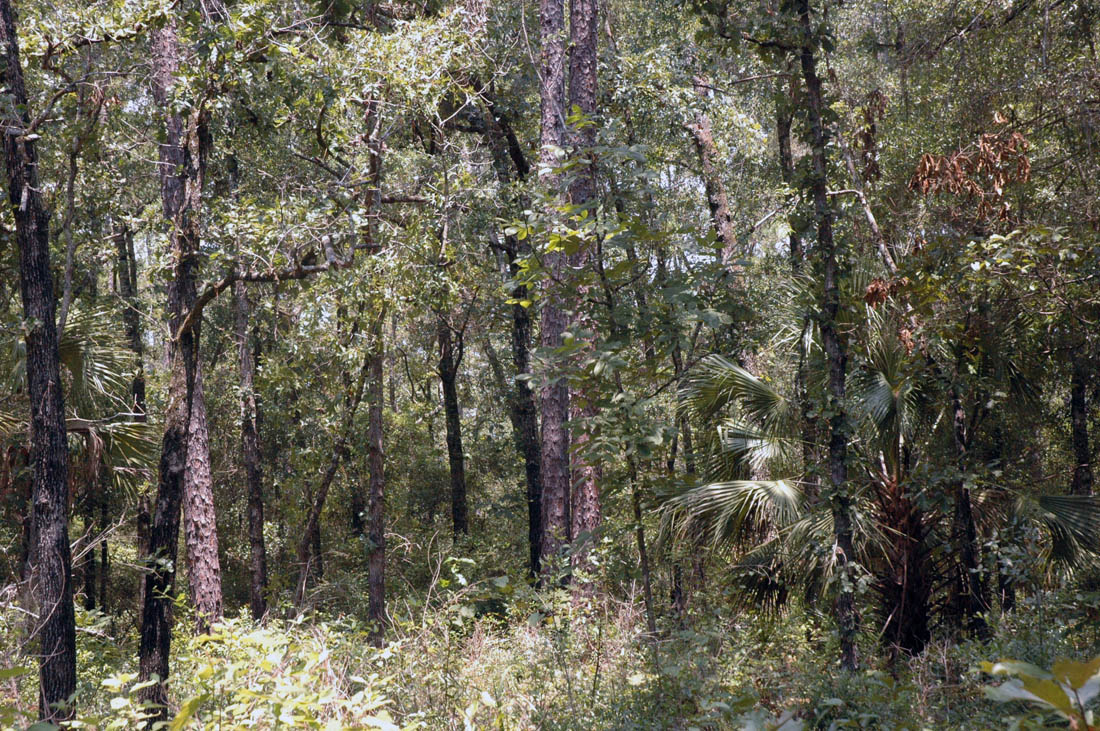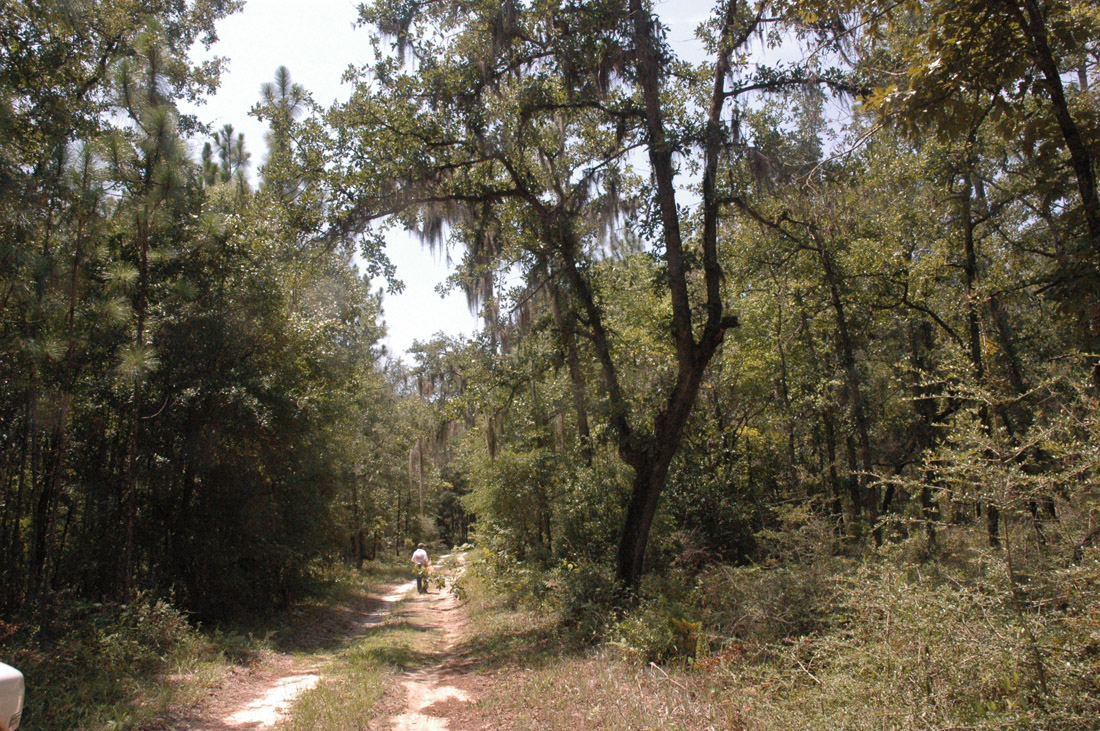The 2011 William H. Cross Expedition
Tall Timbers Research Station, 1-6 August 2011
by Joe MacGown, uploaded on 13 October 2011
Our 26th annual William H. Cross Expedition took place from 1 to 6 August, 2011 in north central Florida and south central Georgia. During the week, we stayed and collected at Tall Timbers Research Station in Leon County, but we also collected in several unique natural areas in the region including the Apalachicola National Forest in Leon County, FL; Apalachicola Bluffs and Ravines Preserve TNC in Liberty Co., FL; Torreya State Park, in Liberty Co., FL; St. Marks National Wildlife Refuge, in Wakulla Co., FL; the Wade Tract (which is managed by Tall Timbers) in Thomas Co., GA; River Creek Wildlife Management Area, in Thomas Co., GA; and the Greenwood Plantation, in Thomas Co., GA. The habitats we collected in were longleaf pine savannas, xeric oak scrub, beech magnolia forests, pine-oak dune forests, hardwood forests along bluffs and ravines bordering creeks and rivers, sandy fields near pine-oak forests or savannas, and hardwood/pine/cabbage palm/palmetto forests. A variety of understories were present in the pine savannas including scrubby second growth vegetation, wiregrass, bracken ferns, runner oaks, and various flowers. The understory was largely determinant on the frequency and time of year that it was burned, the canopy cover, and wetness of the forests.
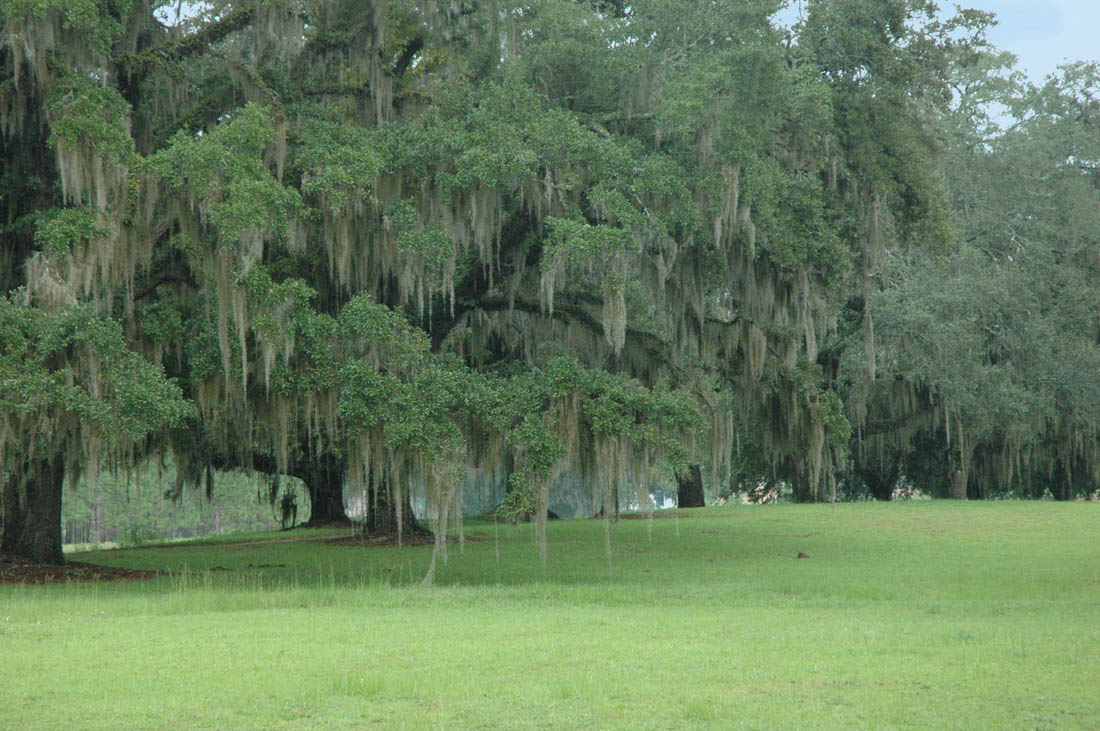
Live oak lining the entrance to Tall Timbers Research Station
Participants for this year's trip included Richard Brown, Terry Schiefer, JoVonn Hill, Sangmi Lee, David Plotkin, Beverly Smith, and me (Joe MacGown). We arrived at the Tall Timbers Research Station at about 6 PM on August 1st and proceeded to unload our gear in the bunkhouse (also referred to as the Den). We referred to the area near the bunkhouse as Tall Timbers Site 1 (30°39'37"N 84°12'31"W). Two researchers, Genevieve Pang and Cody Parmer, also were staying in the bunkhouse, and using it as a base of operations as they conducted their tick and Lyme disease research.
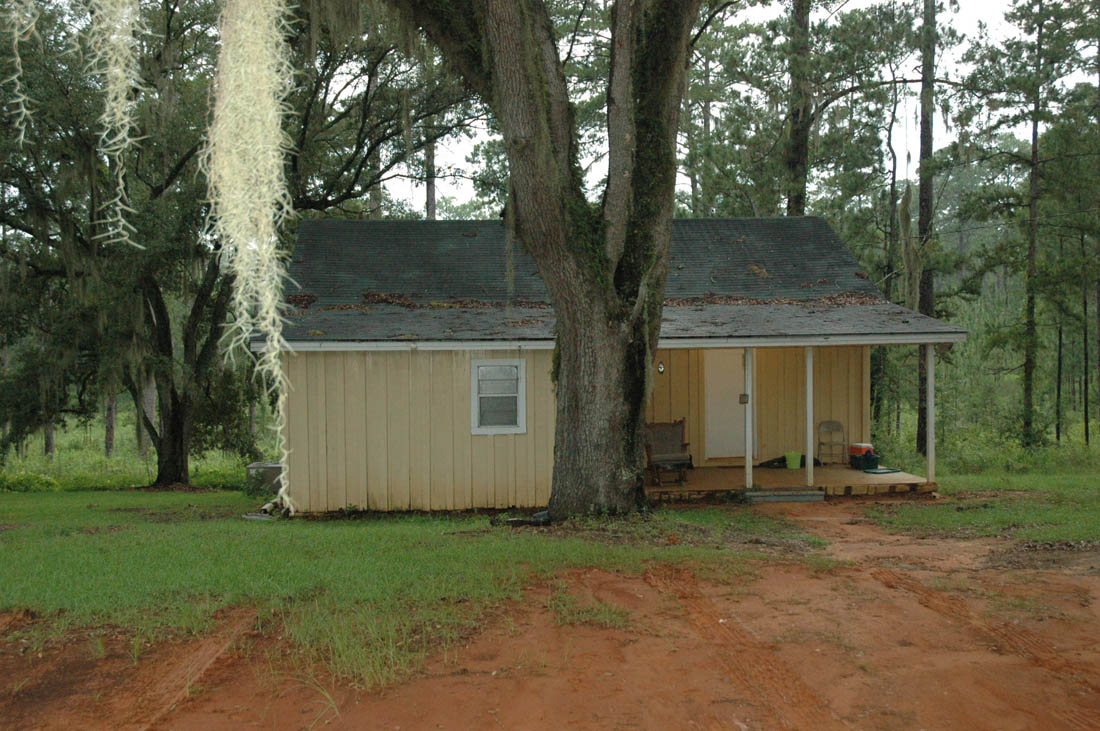
The bunkhouse, also called "the Den", at Tall Timbers
After unloading, JoVonn and I roamed around the immediate area looking for ants and other insects. Not surprisingly for this time of year, it was remarkably hot and humid. Also lending an aid to our overall discomfort was a plethora of no-see-ums! However, the area itself was quite beautiful with majestic live oaks festooned in Spanish Moss and timbering longleaf pines skylining the horizon.
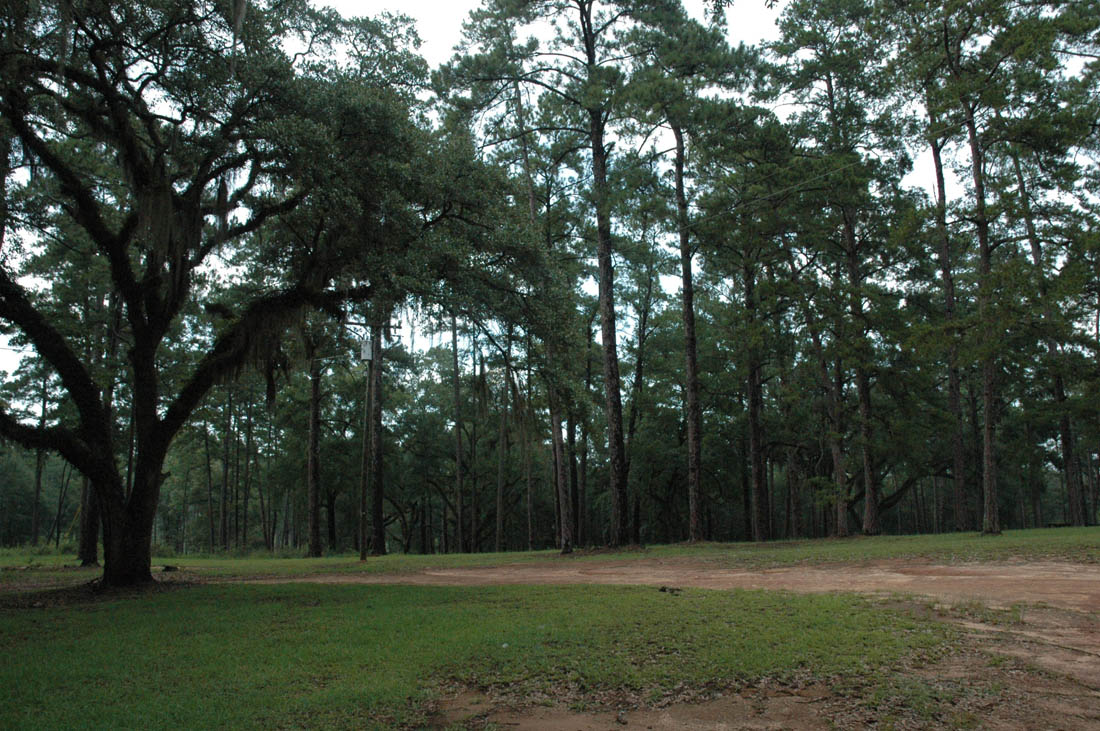
A view of the drive heading into Tall Timbers Research Station
As we roamed around the area we spotted several species of ants that we expected to see in this habitat, several of which were among the many exotic species known to occur in Florida. One of first species seen was the Florida carpenter ant, Camponotus floridanus, a beautiful hairy, red and black species that is relatively common in sandy habitats in the Southeast. This species typically nests in rotting wood, but colonies often extend into the soil below if the wood is laying on the ground. A note of caution - although this species does not sting, workers are aggressive and will bite when disturbed! A colony of the introduced big headed ant Pheidole obscurithorax was discovered next to the Carpenter ant colony. This is the largest Pheidole species in the Southeast, with major workers about the same size of larger fire ants. Fortunately, this species does not sting or bite. We have observed this species successfully competing against imported red fire ants for food resources. We found P. obscurithorax to be abundant throughout the area near the cabin as workers foraged on the ground and on trees. Sifting through the soil revealed another exotic Pheidole species, P. moerens. This species is much smaller and dark reddish-brown in color. It has become quite abundant throughout the Southeast. A native species of Pheidole, P. dentata, was also collected at bait on trees and nesting in soil and rotting wood. And, of course, the imported red fire ant, Solenopsis invicta, was plentiful!
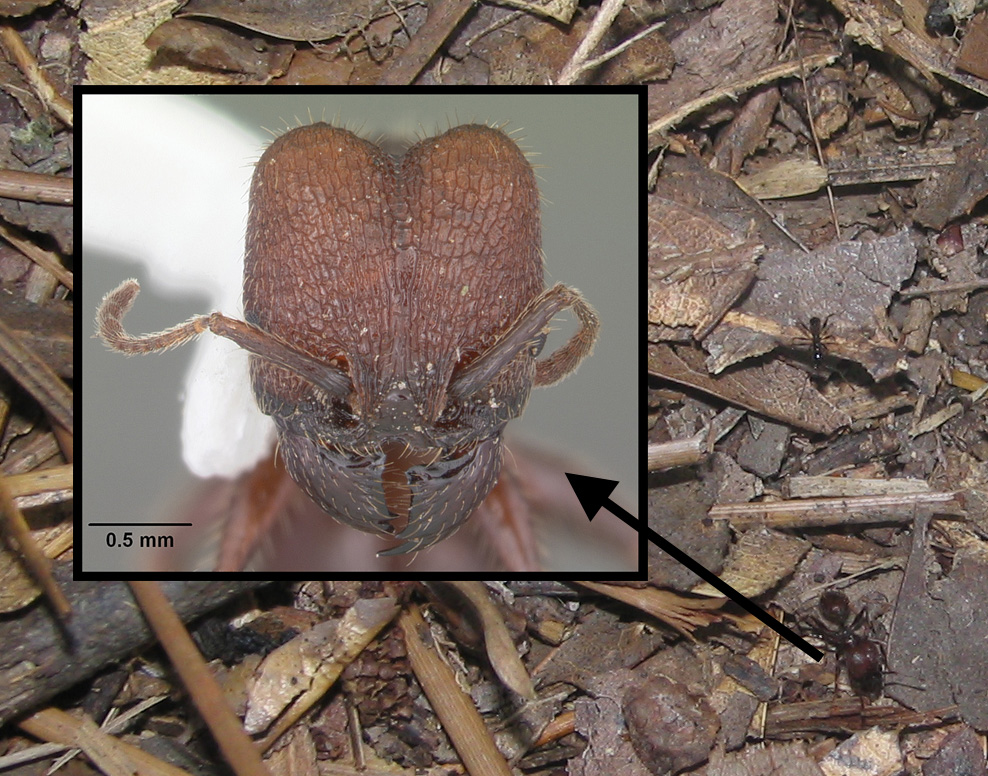
Major worker of Pheidole obscurithorax with close-up of head. Notice the distinct reticulation.
While were scrounging around looking for ants and other assorted arthropods, Richard put up a sheet between two trees behind the cabin area and placed a UV light and mercury vapor light with it. We kept this sheet up for the duration of the trip, typically collecting at it after return blacklighting trips to other sites. Also during this time period, several of the crew went to town for groceries, eventually returning with enough food and water to get us going. Being August, we still had quite some time before the sun went down, so we all sat down to eat a meal together. JoVonn's wife Jennifer had prepared a wonderful Mexican dish, which I believed she called "Good Stuff" for our first meal. There was so much food, we were all almost too stuffed to work, but somehow, we pulled ourselves together and headed out to a longleaf pine savanna site with the Tall Timbers property (site 2 - 30°39'28"N 84°13'07"W) for a night of blacklighting.
Upon arrival at the site, Terry, Richard, and I put up 3 sheets with blacklights, and Richard and I put out one blacklight/bucket trap out, which we left out until the next morning. For this first night of collecting, everyone participated except JoVonn, who stayed at the Den to collect. The very humid weather seemed to have a negative effect on the insects, and collecting was not great. However, there were enough alate ants of several species, w small beetles, microlepidoptera, and other insects to make everyone happy. At about 11 PM, I called it quits, as I was not collecting many new things and was relatively tired from driving all day. Both Terry and Beverly joined me, and headed back to the Den. Richard, Sangmi, and David stayed about one more hour before returning.
Early the next morning on August 2nd, Richard got up early and retrieved the bucket trap. He seeded happy as it contained some nice moths. An abundant supply of male and female Solenopsis pergandei and other alate ant species were also present in the trap, so I was also happy! It was nice to get a good series of winged S. pergandei, which is in a group that I am interested in. This particular species nests in sand, and workers are relatively easy to identify by their milky white coloration.
After sorting some insects from the previous night and smacking down some breakfast, Terry, JoVonn, Beverly, and I headed to a pine-oak scrub site with the Tall Timbers property where we met Dave Almquist, the Invertebrate Zoologist for Florida Natural Areas Inventory. Dave called this the "Scrub Course", although for our purposes it was "Tall Timbers Site 3" (30°40'15"N 84°14'08"W).
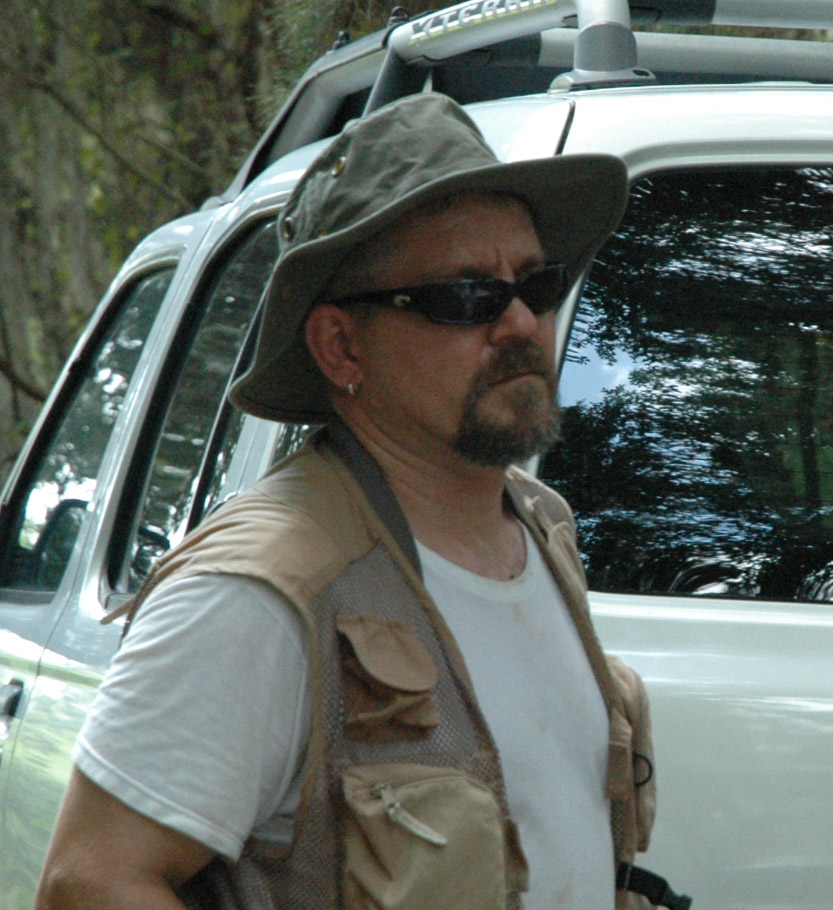
Dave Almquist, Inventory Zoologist extraordinaire!
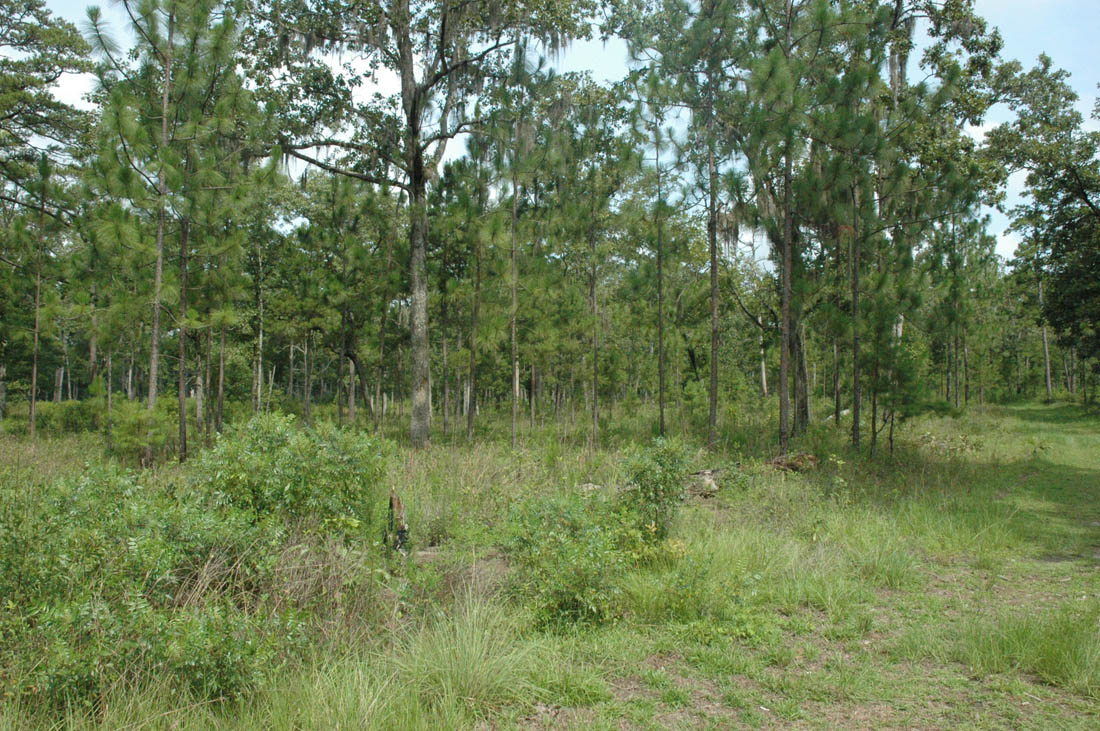
Pine-oak scrub area at Tall Timbers
This site was significantly different from the first in that it seemed much more natural. Certainly, the ants I collected there reflected that. Colonies of the Florida harvester ant, Pogonomyrmex badius, dotted the open sandy road. Equally as common were Forelius mccooki, Dorymyrmex bureni, Pheidole metallescens, and Solenopsis invicta. The wonderfully unique trapjaw ant, Odontomachus bureni, was also quite common, and we observed numerous foraging trails throughout the area and several nests.
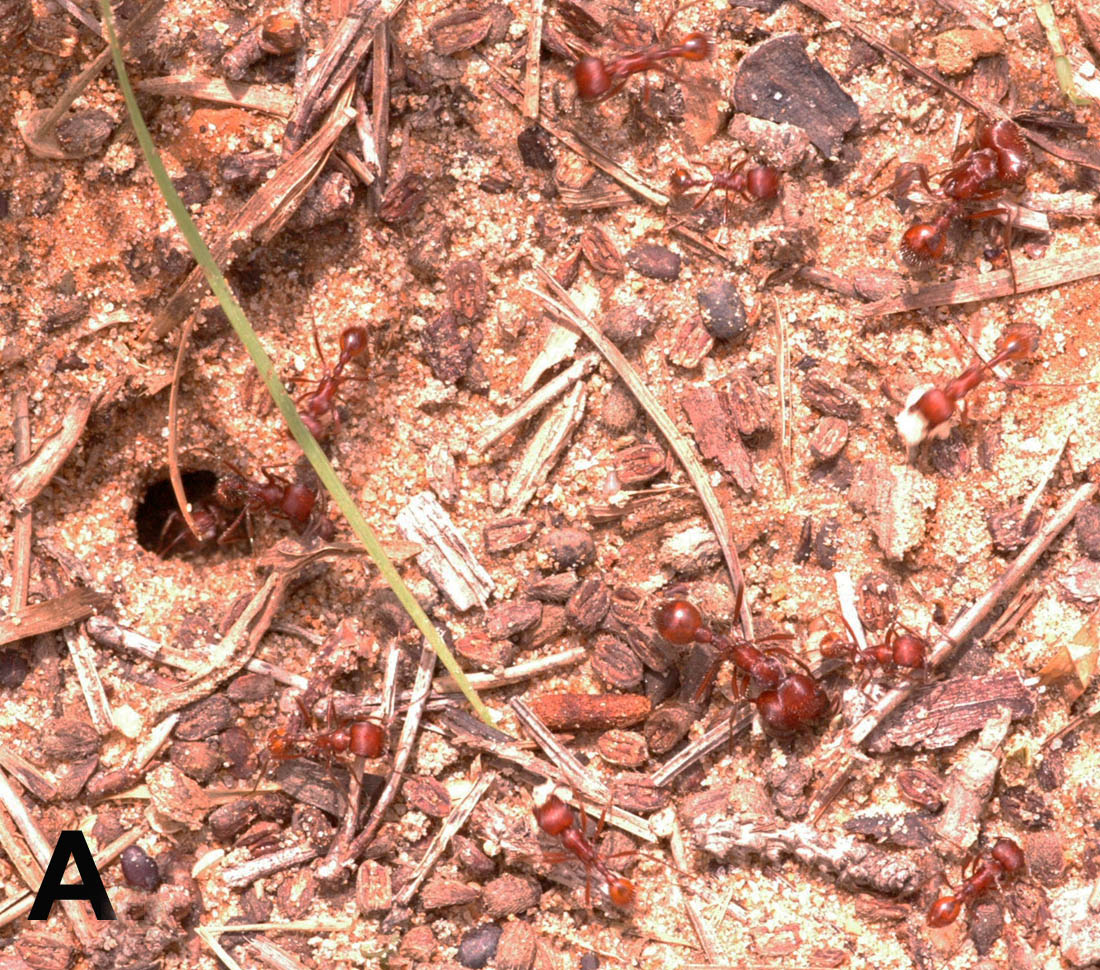
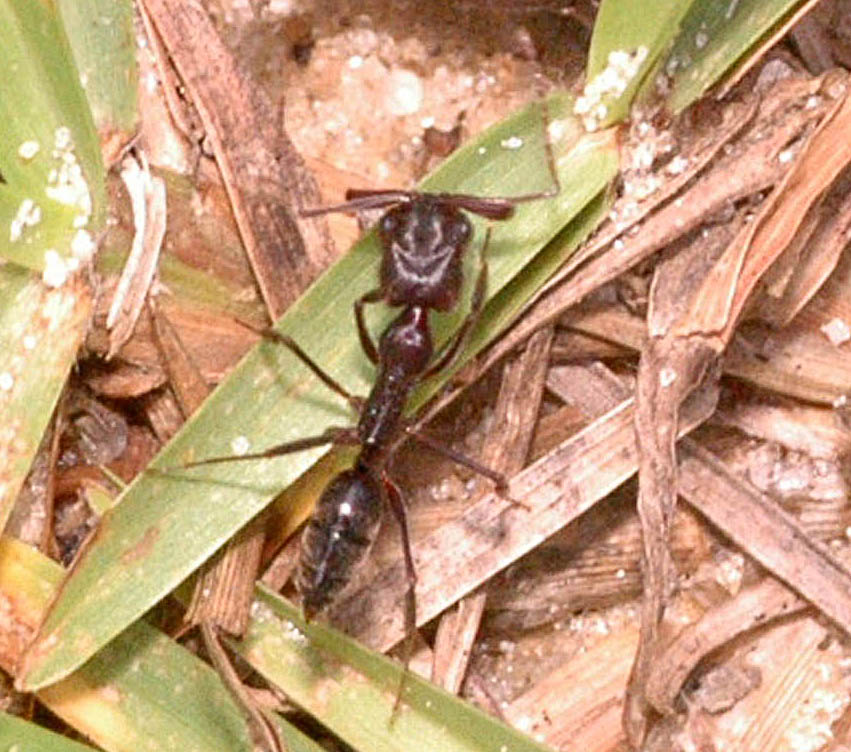
(A) Florida harvester ants workers, Pogonomyrmex badius, near nest entrance and (B) the trap-jaw ant, Odontomachus brunneus foraging with mandibles fully open.
While at this site, Beverly spent her time collecting wild bees on flowers, Terry conducted general collecting, and JoVonn concentrated on finding grasshoppers, as well as ants and other interesting insects.
After spending the morning at the Scrub Course, Dave lead us to a nice beech/magnolia hammock (Tall Timbers Site 4 - 30°38'57"N 84°14'39"W). This area was much lower and wetter, and considerably different from the longleaf pine forests and oak-pine scrub. And, true to the name, beeches and magnolia were plentiful. Adjacent to this area, and basically at the end of the road that lead to the site, was a grassy area that lead into a shallow lake/pond that was mostly covered with aquatic vegetation. While at the site, we spent our time doing general collections, although it was not overly production for diurnally active insects. Of the several ant species found at the site, probably the most interesting find was a strange looking ergatoid male of Hypoponera opacior that was collected in a rotting log by Dave. I find these weird, white-headed, worker-like males occasionally, and I am always struck by their uniqueness.
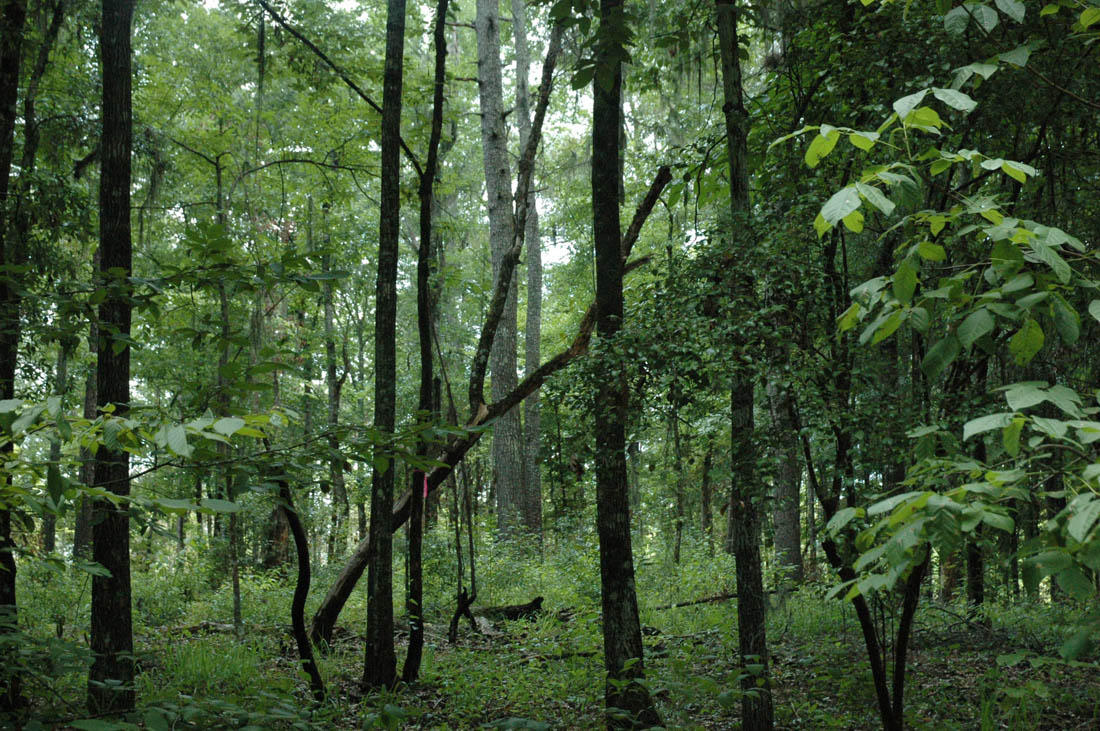
Beech-magnolia hammock at Tall Timbers
After leaving the hammock site, we basically turned around and retraced our way back down the road that lead us there. Along the way back, we stopped at a hardwood forest site that was more upland in nature to collect for a while (Site 5 -30°39'28"N 84°14'40"W). Beverly found more success along the roadway collecting bees on edge type vegetation, while the rest of us wandered through the woods. For me, this site was much more interesting to collect at, and right away I found colonies of the vampire ant Amblyopone pallipes, trap-jaw ants, and more H. opacior with more of the ergatoid males. We stayed at this site for some time, before finally heading back to the Den for some food!
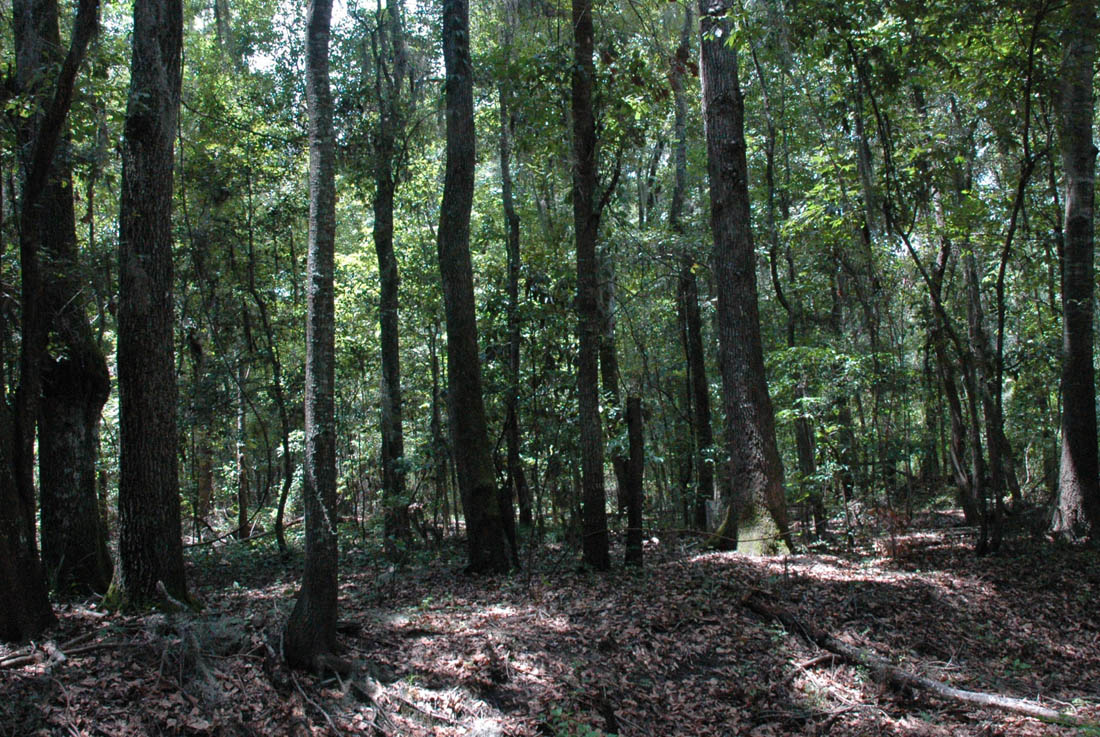
Hardwood forest (Site 4) at Tall Timbers
After eating and chilling out for a while, Terry and I had a few traps to put out. We place a malaise trap and one set of Lindgren funnels out at site 6 (30°39'46"N 84°14'37"W), which was mixed pine savanna with scattered hardwoods habitat at Tall Timbers. We then placed a Lindgren funnel trap in a hardwood forest at site 7 (30°39'35"N 84°14'39"W), one in a hardwood forest at site 8 (30°39'15"N 84°14'39"W), and one in the beech magnolia hammock at site 4 (30°38'57"N 84°14'39"W), all located at Tall Timbers. All of these traps remained until the afternoon of August 5th, when we took them down.
That night we went back to the Scrub Course (Site 3) to blacklight. We put three sheets up and one blacklight/bucket trap out. The entire group came along for this nocturnal adventure. The collecting was again at a similar pace as the previous night, but with some differences in species coming to the sheets. I collected alate males and females of Dorymyrmex bureni, along with several other species of ants. Terry and I scarfed up all the tiny beetles that we could, until getting nice series of many, and the occasional large beetle and anything else lacking scales. Richard, David, and Sangmi spent the evening collecting specimens of every species of moth that flew in, while JoVonn and Beverly collected a wide variety of things. After collecting until near midnight, we went back to the cabin, and several of the crew collected at the sheet there. In fact, with the MV lamp, things were buzzing! Eventually, everyone sorted through their catches and called it a night.

Anxiously awaiting darkness, so we can begin collecting!

Blacklight with sheet at the Scrub Course at Tall Timbers
Early the next morning, August 3rd, Richard picked up the bucket trap. Meanwhile, Terry, JoVonn, Beverly, and I got an early start and drove to Torreya State Park in Liberty County, FL to collect. We made our collections along the Torreya Trail near the park entrance (Site 1- 30°33'33"N 84°56'59"W). The trail wound through some pristine oak-scrub and was much more natural than the Scrub Course at Tall Timbers. I find the ant fauna of these sandhill sites to be remarkably good indicators of habitat quality. Disturbance and lack of burning seems to greatly effect some species, but when you find them, you feel good about the area. In this case, one of the first species of ants I found was Dorymyrmex bossutus, a beautiful bicolored pyramid ant that we have only found in prime sandhill habitats. Colonies of Forelius pruinosus, Monomorium viride, Pogonomyrmex badius, and Aphaenogaster floridana abounded!
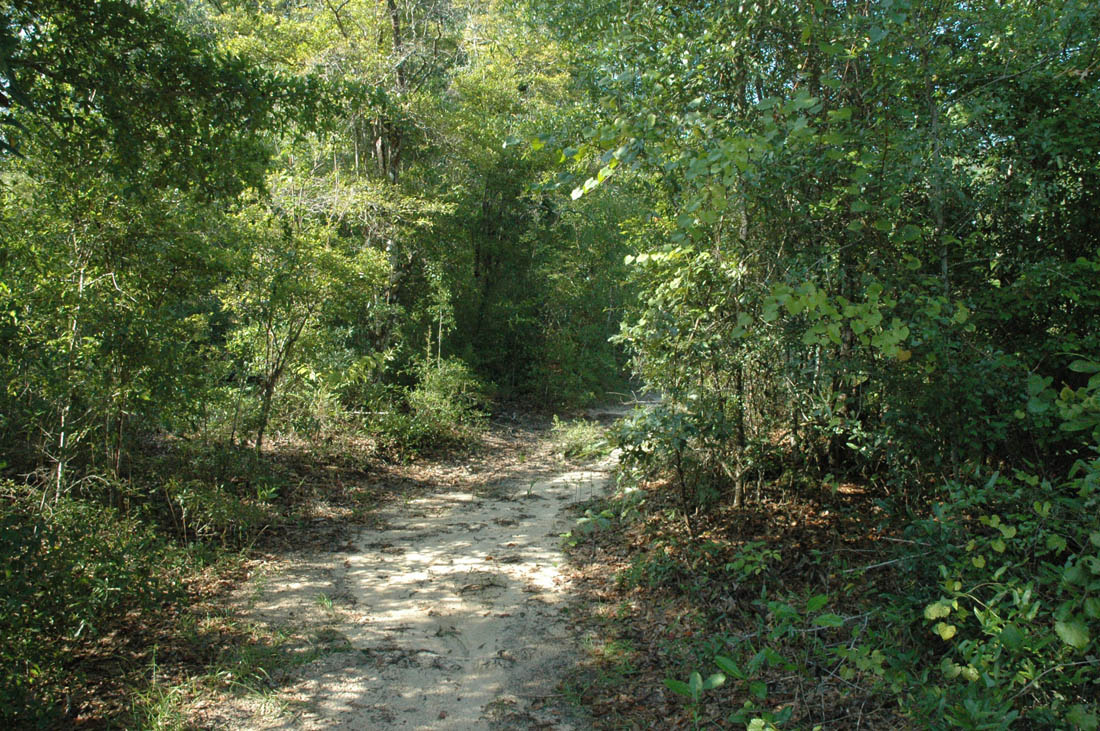
The trail at Torreya State Park
The trail gradually wound its way to a ravine, and eventually overlooked the Apalachicola River. I got sidetracked collecting ants and sifting through some leaf little in a hardwood ravine well before the river (site 2 - 30°33'17"N 84°57'00"W) and never quite made it to the river. The others made it there, however, and also mentioned seeing a Florida Torreya tree, Torreya taxifolia. This tree has a very limited distribution and is only found in sandhill habitats in Torreya State Park (FL), along the eastern side of the Apalachicola River in FL, and in the southern portion of GA that is adjacent to the Florida localities.
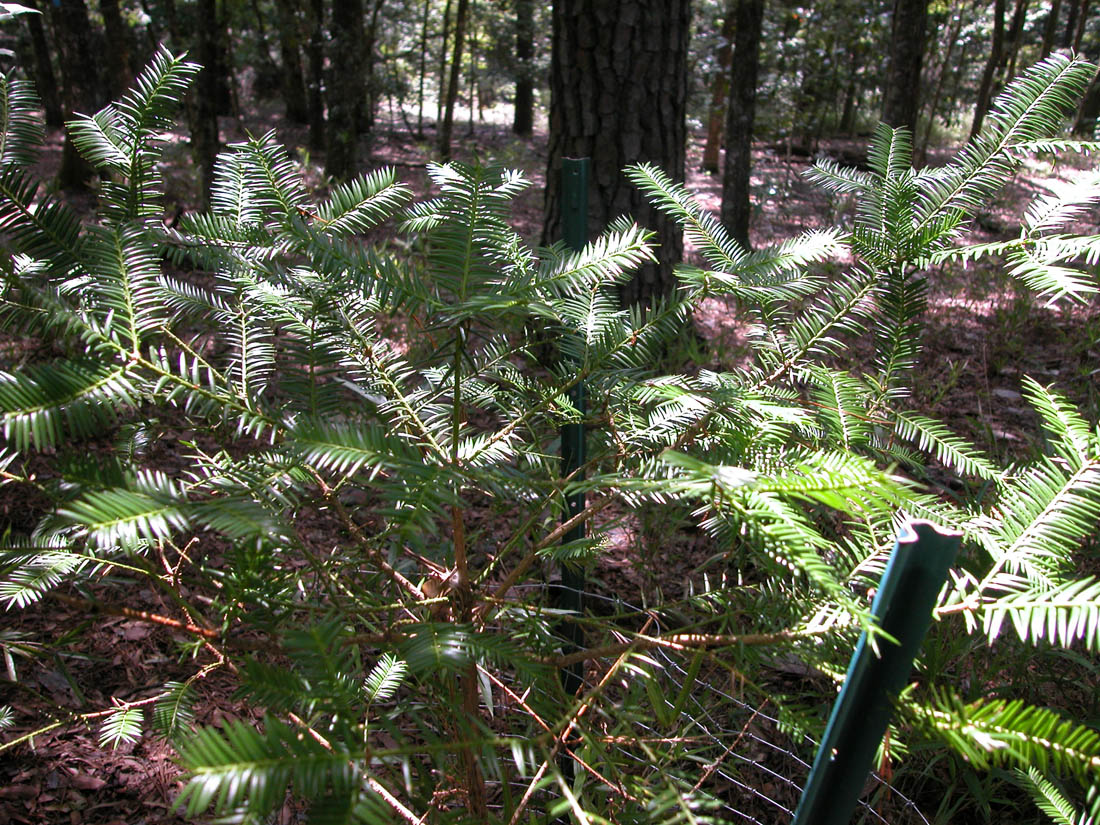
Torreya tree at Torreya State Park
We left Torreya and made our way to the Apalachicola Bluffs and Ravines Preserve, first stopping at the headquarters where we met up with Dave Almquist. We followed Dave to a pristine oak scrub site located along the eastern side of the Apalachicola River in Liberty County, FL. Along the way to our first stop we drove more than a mile down a sugar sand road to our first collecting site, which was near Alum Bluff (30°27'35"N 84°59'22"W). The habitat at this site was relatively thick oak scrub with not too much in the way of large, open sandy areas and hardwood forest habitat on a steep ravine bordering the Apalachicola River. While traipsing along the trail through the hardwood forest, we saw a couple of Florida Yews (Taxus floridana)! The only place this unique tree species is found in the world is here along the eastern bank of the Apalachicola River!

Hardwood forest on ravine slope at Apalachicola N.F.
We collected for a while in the hardwood forest here, with some of the group making their way down to the Apalachicola River bluffs. I never made it that far, as I was satisfied collecting ants and looking through the leaf litter. Our next site (site 2 - 30°27'54"N 84°59'00"W) was in a xeric oak scrub area that was approximately 0.5 miles NE of the first site and back along the road we had entered. Lots of grasshoppers and ants in the area, and quite a few tiger beetles were flying about along the sandy road. The most common tiger beetle we saw here was Cicindela gratiosa, a beautiful pale colored species with a limited southeastern distribution. We collected a few for our collection. Collecting today was similar to the rest of the week, with mind boggling temperatures and outlandish humidity levels. Within seconds of exiting the truck to collect, I was sweating profusely! Its not like I am not used to the heat either, as I run about 60 miles a week in Mississippi, where is it similarly warm and humid! Hydration is key in this weather, and we were downing bottles of water and Gatorade at an amazing rate. Even so, I had to sit down in the shade for minute. Terry, who does not drink as much water as the rest of us because he is part camel, actually seemed to become a bit disoriented! Not particularly unusual for him, but this was definitely heat related. Just to be on the safe side, we called it quits about mid afternoon and ventured to a nearby small town in search of food, water, and air conditioning. We were in luck as we found a diner at the edge of Bristol, where the food was surprisingly good, the waitress was wonderful, the air conditioning was cold, and the tea was excellent!
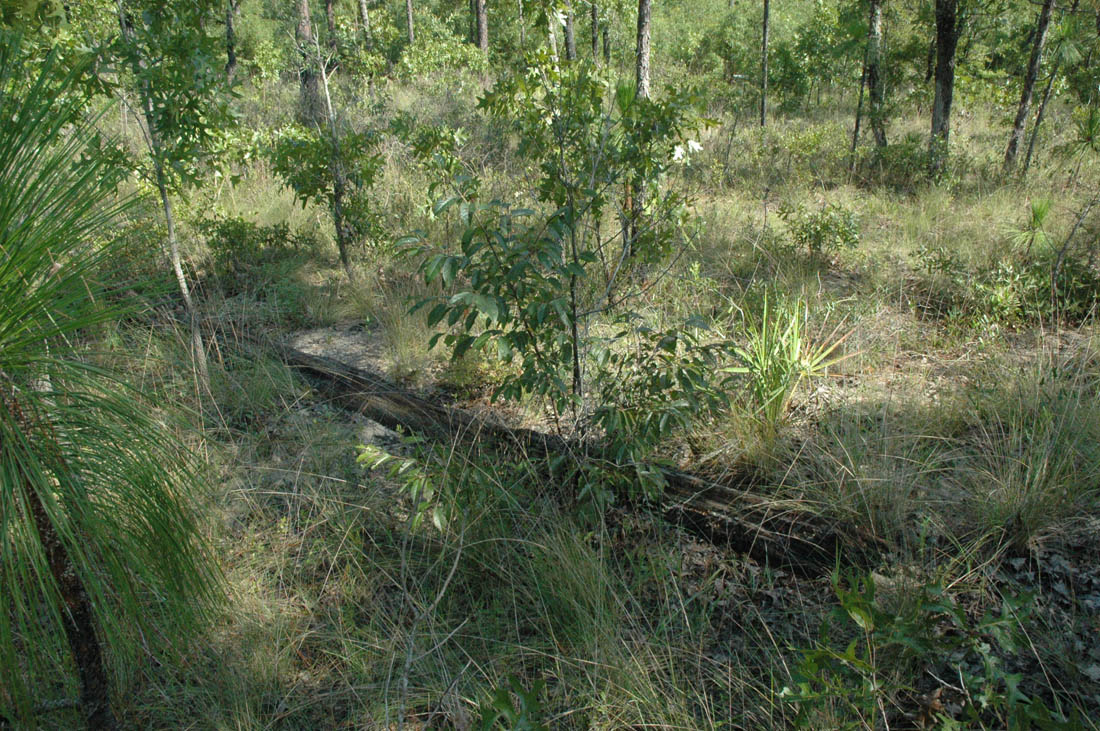
Scrub habitat at Apalachicola N.F.
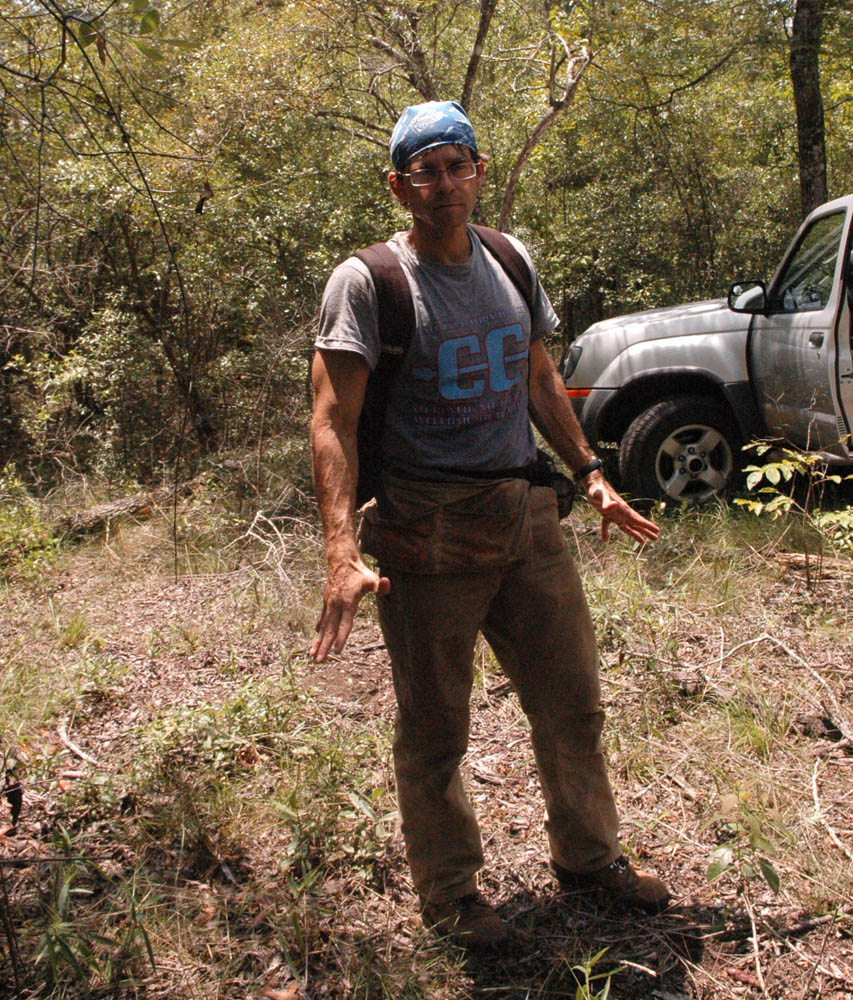
A photo of me (MacGown) completely saturated with sweat!!
Following our delightful departure from the field, we headed back to the Apalachicola Bluffs and Ravines Preserve headquarters (site 3-30°29'33"N 84°58'54"W), where we collected for a couple of hours. Ironically, of all the cool places where we had been thus far, JoVonn seemed to be finding more species of grasshoppers here in a somewhat disturbed scrubby area near the headquarters. I was somewhat surprised to find colonies of Dorymyrmex bossutus here in a relatively disturbed sandhill area. Similar to other places where we had collected during the week, colonies of the Florida carpenter ant were commonly encountered. I found one exceedingly large colony nesting inside of a large dead tree on the ground.
As dusk was fast approaching, we left the headquarters area and returned to the entrance of Sites 1 and 2, where we met Richard, Sangmi, and David. Alas yes, it was time to set up blacklights! However, most of us who had been out all day since 7 AM were bushwhacked and overheated, so all of us except for Terry went back to the Den, skipping out on the blacklighting action. Surprisingly, and yet not, Terry, who had obviously been overheated earlier, opted to stay and collect. I can't blame him really, as he is mostly into longhorn beetles and bark beetles, many of which he collects at light. On the other hand, JoVonn, Beverly, and I find most of our groups during the day. We traded vehicles with them before we left, because the truck we were in was a four wheel drive, necessary for traveling through the fine "sugar" sand road that lead to the collecting sites. It was a good thing too, because they just about got the Ford Expedition buried just parking it near the entrance! When all was said and done, the blacklighting crew had a good night, and Terry was rewarded with his perseverance by collecting several interesting species. In fact, based on the late hour in which they returned, the collecting must have been very good. We were beginning to worry that they got the truck stuck when they finally returned. Collections at sheets that night were made at Site 1b (30°27'37"N 84°59'25"W) in the sloped hardwood forest. Additionally, Richard placed a blacklight/boxtrap out in the oak scrub at site 1. Because this location was so far from our base of operations, he retrieved the boxtrap that night after the sheet collecting was concluded.
Thursday morning started out bright and early, with JoVonn, Beverly, and I driving to a privately owned longleaf pine forest called the Wade Tract, which was located in Thomas County, GA. Although privately owned, this property was managed by the Tall Timbers crew. Our first collecting site (site 1-30°45'35"N 84°00'01"W), was bisected by a road that separated two sections of longleaf forest, one of which had been burned in April. That section was full of various composites, although mostly common species. Also present were 17 million chloropid flies, also called eye gnats or eye flies because of their propensity for being attracted to eyes. These flies were considerably more annoying than any level of heat, although apparently some of the locals did not seem to mind them at all. With all the flowers present, Beverly was able to collect quite a few bee species. JoVonn seemed pleased enough with the grasshopper fauna, Terry spent time doing general collecting, and I collected quite a few ants. There were plenty of Formica dolosa running around, I saw one colony of harvester ants, and collected several species at peanut butter on the pines including D. bureni, F. pruinosus, Pheidole floridana, and Crematogaster pinicola.

Pseudomyrmex gracilis, the graceful twig ant
The next site we collected at in the Wade tract (site 2-30°43'50"N 84°00'29"W) differed in that the understory was almost entirely wiregrass with various open sandy areas. While here we scooped up various flies, bees, wasps, grasshoppers, and ants. Site 3 (30°51'14"N 84°04'09"W) also had a different type of understory, which was primarily composed of palmetto and bracken fern. While collecting at this site, we observed a baby gopher tortoise!
Following our collecting at the Wade Tract, we next went to River Creek Wildlife Management Area, also in Thomas County, GA. Our first stop was a pine savanna site with palmetto and bracken fern understory (site 1-30°51'14"N 84°04'09"W). I grabbed a bag of litter from beneath a large pine, hoping for some decent insects later. I also made my way through an intermittent wetland type area that was currently dry. The forest floor there was made up of a thick sphagnum type layer. The other two spent their time in the open area beneath the pines and along the roadside. We collected here for about an hour, then drove to the headquarters where we met the manager, Joe Burnham. Joe took us over to a nearby privately owned site called the Greenwood Plantation. Apparently, this property had once been a hunting camp for the very rich. Now it was managed for pines, but also with conservation in mind. This old growth forest had pines over 300 years old! We only had limited time to collect, and made our collections at a site with a runner oak and fern understory (Site 1-30°50'19"N 84°00'40"W). Grasshoppers abounded!
We left Greenwood, and returned to River Creek WMA. Joe Burnham showed us a nice hardwood forest site on a bluff along a creek (site 2-30°51'18"N 84°04'37"W). We were only here a few minutes before it began to rain. JoVonn and I quickly grabbed three pillowcases full of leaf litter for later Berlese extraction. Then, before it got too wet, we quickly went to another bluff site (site 3-30°51'20"N 84°03'17"W), where I got another bag of litter.
At about dusk, the rest of the crew showed up, and we put up three sheet and blacklights in a pine savanna (site 4-30°51'41"N 84°04'03"W). It was wet, but the rain had stopped. JoVonn and Richard put a box trap out at site 2 in the hardwood forest. Probably due to the late rain, the humidity level was quite high, so collecting was not only uncomfortable, it was also fairly slow. We called it quits early and returned to our humble abode where we collected at the sheet there, sorted our catch, and finally went to sleep.
On Friday morning, August 5th, Terry, Beverly, JoVonn, and I drove to an Apalachicola National Forest site in Leon County, FL where we again met Dave Almquist. This was another open pine savanna site bordered by hardwood forest and interwoven with mountain bike/hiking trails. The area was called "Munson Trails", but we also called it site 4 (30°21'12"N 84°15'37"W). We collected here for a while and found some species we had not seen elsewhere. Beverly spent much of her time snapping up bees nectaring at partridge pea flowers (Chamaechrista fasciculata), while JoVonn grabbed several grasshopper species. Terry spent his time beating limbs of trees and bushes in the hardwood strip between the site and the highway. I spent most of my time collecting ants, but also collected bees, beetles, and other insects. This was the only site thus far where we found Camponotus socius, a beautiful carpenter ant species. Workers of both this species and Formica pallidefulva, a shiny orange red ant, were collected on partridge pea. Numerous colonies of the Florida harvester ant, the red imported fire ant, the pyramid ant (D. bureni), and Forelius pruinosus were present. Additionally, we collected three species of twig ants: Pseudomyrmex ejectus, P. gracilus, and P. pallidus.
After collecting at Munson Trails for a couple of hours, it was time for a new site. JoVonn left us at that point to make some collections some other sites in Georgia, Tennessee, and North Carolina as part of a grasshopper faunal survey he is doing. The rest of us followed Dave to St. Marks National Wildlife Refuge in Wakulla County, FL, which was very near the coastline. Our first collecting site (site 1- 30°07'19"N 84°18'40"W) was a beautiful mix of oak scrub, cabbage palm, palmetto, and pine forest forest.
Time was limited, but we all got in some general collecting. I also grabbed a big bag of litter from beneath a cabbage palm, Sabal palmetto. It was great to collect in an area with native palms!
After only about 30 minutes of collecting, we next headed to the site 2 (30°07'15"N 84°18'29"W), which was basically an a sandy field bordering a pine savanna. Lots of partridge pea here, so Beverly had something to collect bees from. While we were here, Dave showed us his cool invention, a trap that mimicked a gopher tortoise burrow for collecting insects associated with the tortoises. Apparently, the trap if very effective and provides a relatively easy way to collect most of these insects.
That evening, we set up blacklights at Tall Timbers in pine savanna with scattered hardwoods (site-630°39'46"N 84°14'37"W). I did not blacklight that night, because I did not want to be up all night before driving back to Starkville the next day. The other folks all went, and Terry mentioned that he got some nice beetles! Eventually, they all returned to the den and things wound down. We said our good-byes to Cody and Genevieve, and called it a night.
The next morning, we packed and loaded the trucks and returned to MSU.
Collecting Sites
FLORIDA SITES
Tall Timbers Research Station
Site 1, Camp area (general collecting, MV and BL/ sheet -1-5 August)
FLA., Leon Co.
Tall Timbers Res. Sta.
30°39'37"N 84°12'31"W
live oak/pine forest
Site 2, pine savanna area – (3 blacklight/sheets – 1 August)
FLA., Leon Co.
Tall Timbers Res. Sta.
30°39'28"N 84°13'07"W
pine savanna
Site 2b, pine savanna area – (box trap– 1 August)
FLA., Leon Co.
Tall Timbers Res. Sta.
30°39'32"N 84°12'34"W
pine savanna
Site 3, scrub course – (day collecting, blacklight and box trap – 2 August)
FLA., Leon Co.
Tall Timbers Res. Sta.
30°40'15"N 84°14'08"W
oak-pine scrub
Site 4 or Lindgren Site 4 - Beech Magnolia forest – (day collecting - 2 August, Lindgrens 2-5 August)
FLA., Leon Co.
Tall Timbers Res. Sta.
30°38'57"N 84°14'39"W
beech magnolia forest
Site 5, hardwood forest – (day collecting - 2 August)
FLA., Leon Co.
Tall Timbers Res. Sta.
30°39'28"N 84°14'40"W
hardwood forest
Site 6 or Malaise/Lindgren Site 1 – (Malaise Trap, Lindgren funnels – 2-5 August)
FLA., Leon Co.
Tall Timbers Res. Sta.
30°39'46"N 84°14'37"W
pine savanna (with scattered hardwoods)
Site 7 or Lindgren Site 2 – (Lindgren funnels – 2-5 August)
FLA., Leon Co.
Tall Timbers Res. Sta.
30°39'35"N 84°14'39"W
hardwood forest
Site 8 or Lindgren Site 3 – (Lindgren funnels – 2-5 August, blacklight/sheets 5 August)
FLA., Leon Co.
Tall Timbers Res. Sta.
30°39'15"N 84°14'39"W
hardwood forest
Torreya State Park
Site 1, trail near beginning of park (day collecting, 3 August)
FLA., Liberty Co.
Torreya State Park
30°33'33"N 84°56'59"W
oak-pine scrub
Site 2, ravine site down trail (day collecting, 3 August)
FLA., Liberty Co.
Torreya State Park
30°33'17"N 84°57'00"W
hardwood forest on ravine
slope by pine/oak scrub
Apalachicola Bluffs & Ravines Preserve - Liberty County
Site 1, near Alum Bluff (day collecting, 3 August, one sheets and box trap)
FLA., Liberty Co.
Apalachicola Bluffs
& Ravines Preserve
30°27'35"N 84°59'22"W
oak scrub
Site 1b, ravine near Alum Bluff (two sheets, 3 Aug)
FLA., Liberty Co.
Apalachicola Bluffs
& Ravines Preserve
30°27'37"N 84°59'25"W
hardwood forest
in ravine near river
Site 2, (day collecting, 3 August)
FLA., Liberty Co.
Apalachicola Bluffs
& Ravines Preserve
30°27'54"N 84°59'00"W
zeric oak scrub
Site 3, Headquarters (day collecting, 3 August)
FLA., Liberty Co.
Apalachicola Bluffs
& Ravines Preserve
30°29'33"N 84°58'54"W
pine/oak scrub
Apalachicola National Forest - Leon County
Site 1, Munson Trails (day collecting, 5 August)
FLA., Leon Co.
Apalachicola N.F.
30°21'12"N 84°15'37"W
pine savanna
hardwood forest
St. Marks NWR
Site 1, (day collecting, 5 August)FLA., Wakulla Co.
St. Marks NWR
30°07'19"N 84°18'40"W
oak scrub-cabbage palm
palmetto, pine forest
Site 2, (day collecting, 5 August)
FLA., Wakulla Co.
St. Marks NWR
30°07'15"N 84°18'29"W
sandy field near
longleaf pine savanna
GEORGIA SITES
Wade Tract
Site 1, (day collecting, 4 August)
GA, Thomas Co.
Wade Tract, Tall Timbers
30°45'35"N 84°00'01"W
Longleaf pine savanna
(recently burned)
Site 2, (day collecting, 4 August)
GA, Thomas Co.
Wade Tract, Tall Timbers
30°43'50"N 84°00'29"W
Longleaf pine savanna
-wiregrass understory
Site 3, (day collecting, 4 August)
GA, Thomas Co.
Wade Tract, Tall Timbers
30°51'14"N 84°04'09"W
Longleaf pine savanna
-palmetto/bracken fern
understory
Greenwood Plantation
Site 1, (day collecting, 4 August)
GA, Thomas Co.
Greenwood Plantation
30°50'19"N 84°00'40"W
Longleaf pine savanna-
runner oak, fern understory
River Creek Wildlife Management Area
Site 1, (day collecting – 4 August)
GA, Thomas Co.
River Creek WMA
30°51'14"N 84°04'09"W
longleaf pine savanna
palmetto/bracken fern
understory
Site 2, (day collecting & 3 pillowcases litter - 4 August, boxtrap – 4 August)
GA, Thomas Co.
River Creek WMA
30°51'18"N 84°04'37"W
hardwood forest on
bluff near creek
Site 3, (day collecting & 1 pillowcase litter - 4 August)
GA, Thomas Co.
River Creek WMA
30°51'20"N 84°03'17"W
hardwood forest on
bluff near river
Site 4, (3 blacklights/sheets - 4 August)
GA, Thomas Co.
River Creek WMA
30°51'41"N 84°04'03"W
Longleaf pine
savanna
Links
Ants collected on 2011 Cross Expedition


